Mobile Applications
The center explores and develops distributed application designs that work across mobile devices and compute/storage clouds. This research includes new programming models, abstractions, and communication protocols for mobile environments. Focus applications include transportation systems and vehicle-to-vehicle networks, scalable mobile video, personalized content delivery, sensor-intensive tasking and coordination applications, and more.
Research topics
Wi-Vi: See Through Walls with Wi-Fi SignalsDina KatabiWi-Vi is a new technology that enables seeing through walls using Wi-Fi signals. It allows us to track moving humans through walls and behind closed doors. Wi-Vi relies on capturing the reflections of its own transmitted signals off moving objects behind a wall in order to track them. Wi-Vi's operation does not require access to any device on the other side of the wall. |
 CHRISTINE DANILOFF/MIT |
Alfalfa: real-time interactive protocols that work well over wireless networksHari BalakrishnanAlfalfa is an Internet videoconferencing protocol that works well over cellular wireless networks, where link speeds change dramatically with time, and current transport protocols build up lengthy in-network queues. Alfalfa does not use TCP-style reactive congestion control, but instead uses a stochastic model of the network path to forecast how many bytes are safe to send, while bounding the risk that its packets will be queued inside the network for too long. |
 |
Mosh: mobile shellHari BalakrishnanRemote terminal application that allows roaming, supports intermittent connectivity, and provides intelligent local echo and line editing of user keystrokes. Mosh is a replacement for SSH. It's more robust and responsive, especially over Wi-Fi, cellular, and long-distance links. Mosh is free software, available for GNU/Linux, FreeBSD, and Mac OS X. |
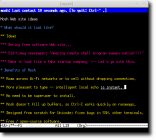 Mosh in use |
Code In The Air - Simplifying Sensing and Coordination Tasks on SmartphonesHari BalakrishnanCode in the Air (CITA), a system which simplifies the rapid development of tasking applications. It enables non-expert end users to easily express simple tasks on their phone, and more sophisticated developers to write code for complex tasks by writing purely server-side scripts. CITA provides a task execution framework to automatically distribute and coordinate tasks, energy-efficient modules to infer user activities and compose them, and a push communication service for mobile devices that overcomes some shortcomings in existing push services. |
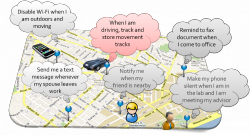 Code In The Air |
Traffic-Aware Techniques to Reduce 3G/LTE Wireless Energy ConsumptionHari BalakrishnanThe
3G/LTE wireless interface is a significant contributor to battery drain
on mobile devices. A large portion of the energy is consumed by
unnecessarily keeping the mobile device’s radio in its “Active” mode
even when there is no traffic. This pproject aims to reduce this portion
of energy consumption by learning the traffic patterns and predicting
when a burst of traffic will start or end. We develop a technique to
determine when to change the radio’s state to optimize energy
efficiency. |
 |
SoftCast: A Cross-Layer Design for Scalable Mobile VideoDina KatabiIn broadcast and mobile scenarios the bit rate supported by the channel differs across receivers and varies quickly over time. The conventional design however forces the source to pick a single bit rate and degrades sharply when the channel cannot not support the chosen bit rate. SoftCast is a clean-slate design for wireless video where the source transmits one video stream that each receiver decodes to a video quality commensurate with its specific instantaneous channel quality. |
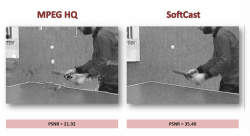 |
Aggregation in Dynamic NetworksCalvin NewportThe aggregation problem assumes that every process starts an execution with a unique token (an abstraction for data). The goal is to collect these tokens at a minimum number of processes by the end of the execution. This problem is particularly relevant to mobile networks where peer-to-peer communication is cheap (e.g., using 802.11 or Bluetooth), but uploading data to a central server can be costly (e.g., using 3G/4G). With this in mind, we study this problem in a dynamic network model, in which the communication graph can change arbitrarily from round to round. We start by exploring {\em global} bounds. First we prove a negative result that shows that in general dynamic graphs no algorithm can achieve any measure of competitiveness against the optimal offline algorithm. Guided by this impossibility result, we focus our attention to dynamic graphs where every node interacts, at some point in the execution, with at least a $p$-fraction of the total number of nodes in the graph. We call these graphs $p$-clusters. We describe a distributed algorithm that in $p$-clusters aggregates the tokens to $O(\log n)$ processes with high probability. We then turn our attention to {\em local} bounds. Specifically we ask whether its possible to aggregate to $O(\log{n})$ processes in parts of the graph that locally form a $p$-cluster. Here we prove a negative result: this is only possible if the local $p$- clusters are sufficiently isolated from the rest of the graph. We then match this result with an algorithm that achieves the desired aggregation given (close to) the minimal required $p$-cluster isolation. Together, these results imply a ``paradox of connectivity'': in some graphs, increasing connectivity can lead to inherently worse aggregation performance. We conclude by considering what it seems to be a promising performance metric to circumvent our lower bounds for local aggregation algorithms. However, perhaps surprisingly, we show that no aggregation algorithm can perform well with respect to this metric, even in very well connected and very well isolated clusters.
|
 Christine Daniloff |
CarSpeak: A Content-Centric Network for Autonomous DrivingDaniela Rus, Dina KatabiWe introduce CarSpeak, a communication system for autonomous driving. CarSpeak enables a car to query and access sensory information captured by other cars in a manner similar to how it accesses information from its local sensors. CarSpeak adopts a content-centric approach where information objects -- i.e., regions along the road -- are first class citizens. It names and accesses road regions using a multi-resolution system, which allows it to scale the amount of transmitted data with the available bandwidth. |
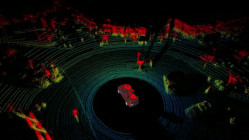 Sensor Data Visualization from an Autonomous Car |
Efficient and Reliable Backscatter NetworksDina KatabiThere
is a long-standing vision of embedding backscatter nodes like RFIDs
into everyday objects to build ultralow power ubiquitous networks. A
major problem that has challenged this vision is that backscatter
communication is neither reliable nor efficient. Backscatter nodes
cannot sense each other, and hence tend to suffer from colliding
transmissions. Further, they are ineffective at adapting the bit rate to
channel conditions, and thus miss opportunities to increase throughput,
or transmit above capacity causing errors. |
 |
TIMO : Making 802.11n Robust to Cross-Technology InterferenceDina KatabiCross-technology interference is emerging as a major problem for 802.11 networks. Independent studies in 2010 by the Farpoint Group, BandSpeed, and Miercom all show that highpower interferers like baby monitors and cordless phones can cause 802.11n networks to experience a complete loss of connectivity. Other studies from Ofcom, Jupiter Research, and Cisco report that such interferers are responsible for more than half of the problems reported in customer networks. |
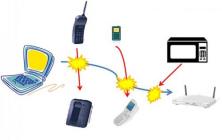 |
802.11n+ : Random Access Heterogeneous MIMO NetworksDina KatabiThis project presents the design and implementation of 802.11n+, a fully distributed random access protocol for MIMO networks. 802.11n+ allows nodes that differ in the number of antennas to contend not just for time, but also for the degrees of freedom provided by multiple antennas. We show that even when the medium is already occupied by some nodes, nodes with more antennas can transmit concurrently without harming the ongoing transmissions. Furthermore, such nodes can contend for the medium in a fully distributed way. |
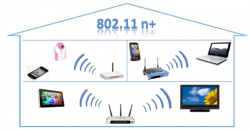 |
MegaMIMO: Scaling Wireless Capacity with User DemandsDina KatabiWe present joint multi-user beamforming (JMB), a system that enables independent access points (APs) to beamform their signals, and communicate with their clients on the same channel as if they were one large MIMO transmitter. The key enabling technology behind JMB is a new low-overhead technique for synchronizing the phase of multiple transmitters in a distributed manner. The design allows a wireless LAN to scale its throughput by continually adding more APs on the same channel. |
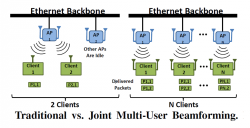 |



